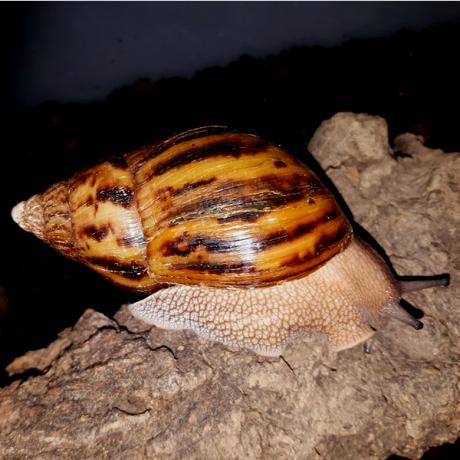

The largest land snail on Earth. Easy to keep and care for, ideal for novices and experienced keepers.
| Origin | West Africa |
|---|---|
| Environment | Forest floor, coastal regions |
| Adult Size | Up to 30cm |
| Suitability | Novice keeper |
| Lifespan | Up to 10 years |
| Food Type | Fruit, flowers, vegetables |
Achatina achatina are the largest recorded land snail species in the world. Specimens have been recorded as large as 30cm in shell length and 15cm in diameter; although rare. In captivity, hobbyists report averages of 18cm shell length and 9cm diameter. The shell is conical in shape.
All true specimens of Achatina achatina are light or dark brown in colour and have 6-8 distinctive dark zig-zag lines running the length of their shell.
This species is found throughout West Africa, but predominantly around southern coastal regions in Ghana, Cameroon, Nigeria and Sierra Leone; where it hot and humid year-round.
Deforestation and snail-picking have caused numbers of Achatina achatina to dramatically fall in the wild. They are considered a prized snail for eating by local people.
House singular or in small groups (if breeding) in a suitably sized plastic tank or glass terrarium. Maintain temperatures between 28°C (82°F) and 30°C (86°F) using appropriate heating equipment. Maintain a high humidity of 85-90% with regular misting using a hand or pump sprayer.
Provide a substrate layer of coco fibre or peat which is deep enough for them to burrow into and add a clump of sphagnum moss in the corner for them to hide under.
Calcium is a hugely important part of a land snails diet. It helps them grow and maintain a healthy shell. Cuttlefish bones are the most widely accepted way of offering calcium to pet land snails.
Achatina achatina eat a huge variety of different fruits, flowers and vegetables. We've summarised many of the commonly available foods in the feeding table below.
| Fruits | Apple, pear, grapes kiwi, papaya, mango, dragon fruit, strawberries, raspberries, blueberries, banana, watermelon, honeydew melon, tomato, butternut squash and peach |
|---|---|
| Vegetables | Aubergine, broccoli, cabbage, courgette, cucumber, kale, spinach, sweet potato, dandelion leaves and flowers, carrot, green beans, mushrooms, romaine lettuce and baby gem lettuce |